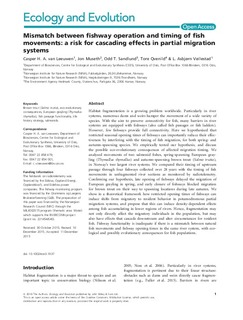| dc.contributor.author | van Leeuwen, Casper | |
| dc.contributor.author | Museth, Jon | |
| dc.contributor.author | Sandlund, Odd Terje | |
| dc.contributor.author | Qvenild, Tore | |
| dc.contributor.author | Vøllestad, Leif Asbjørn | |
| dc.date.accessioned | 2016-03-14T11:15:12Z | |
| dc.date.accessioned | 2016-03-30T11:16:18Z | |
| dc.date.available | 2016-03-14T11:15:12Z | |
| dc.date.available | 2016-03-30T11:16:18Z | |
| dc.date.issued | 2016 | |
| dc.identifier.citation | Ecology and Evolution 2016 | nb_NO |
| dc.identifier.issn | 2045-7758 | |
| dc.identifier.uri | http://hdl.handle.net/11250/2383071 | |
| dc.description.abstract | Habitat fragmentation is a growing problem worldwide. Particularly in river
systems, numerous dams and weirs hamper the movement of a wide variety of
species. With the aim to preserve connectivity for fish, many barriers in river
systems are equipped with fishways (also called fish passages or fish ladders).
However, few fishways provide full connectivity. Here we hypothesized that
restricted seasonal opening times of fishways can importantly reduce their effectiveness
by interfering with the timing of fish migration, for both spring- and
autumn-spawning species. We empirically tested our hypothesis, and discuss
the possible eco-evolutionary consequences of affected migration timing. We
analyzed movements of two salmonid fishes, spring-spawning European grayling
(Thymallus thymallus) and autumn-spawning brown trout (Salmo trutta),
in Norway’s two largest river systems. We compared their timing of upstream
passage through four fishways collected over 28 years with the timing of fish
movements in unfragmented river sections as monitored by radiotelemetry.
Confirming our hypothesis, late opening of fishways delayed the migration of
European grayling in spring, and early closure of fishways blocked migration
for brown trout on their way to spawning locations during late autumn. We
show in a theoretical framework how restricted opening times of fishways can
induce shifts from migratory to resident behavior in potamodromous partial
migration systems, and propose that this can induce density-dependent effects
among fish accumulating in lower regions of rivers. Hence, fragmentation may
not only directly affect the migratory individuals in the population, but may
also have effects that cascade downstream and alter circumstances for resident
fish. Fishway functionality is inadequate if there is a mismatch between natural
fish movements and fishway opening times in the same river system, with ecological
and possibly evolutionary consequences for fish populations. | nb_NO |
| dc.language.iso | eng | nb_NO |
| dc.rights | Navngivelse-Ikkekommersiell-DelPåSammeVilkår 3.0 Norge | * |
| dc.rights.uri | http://creativecommons.org/licenses/by-nc-sa/3.0/no/ | * |
| dc.subject | Brown trout (Salmo trutta) | nb_NO |
| dc.subject | eco-evolutionary consequences | nb_NO |
| dc.subject | European grayling (Thymallus thymallus) | nb_NO |
| dc.subject | fish passage functionality | nb_NO |
| dc.subject | life history strategy | nb_NO |
| dc.subject | salmonids | nb_NO |
| dc.title | Mismatch between fishway operation and timing of fish movements: a risk for cascading effects in partial migration systems | nb_NO |
| dc.type | Peer reviewed | nb_NO |
| dc.type | Journal article | |
| dc.date.updated | 2016-03-14T11:15:12Z | |
| dc.subject.nsi | VDP::Mathematics and natural science: 400 | nb_NO |
| dc.subject.nsi | VDP::Mathematics and natural science: 400::Zoology and botany: 480::Ecology: 488 | nb_NO |
| dc.source.pagenumber | 12 | nb_NO |
| dc.source.journal | Ecology and Evolution | nb_NO |
| dc.identifier.doi | 10.1002/ece3.1937 | |
| dc.identifier.cristin | 1344304 | |
| dc.relation.project | Norges forskningsråd: 179569 | nb_NO |

